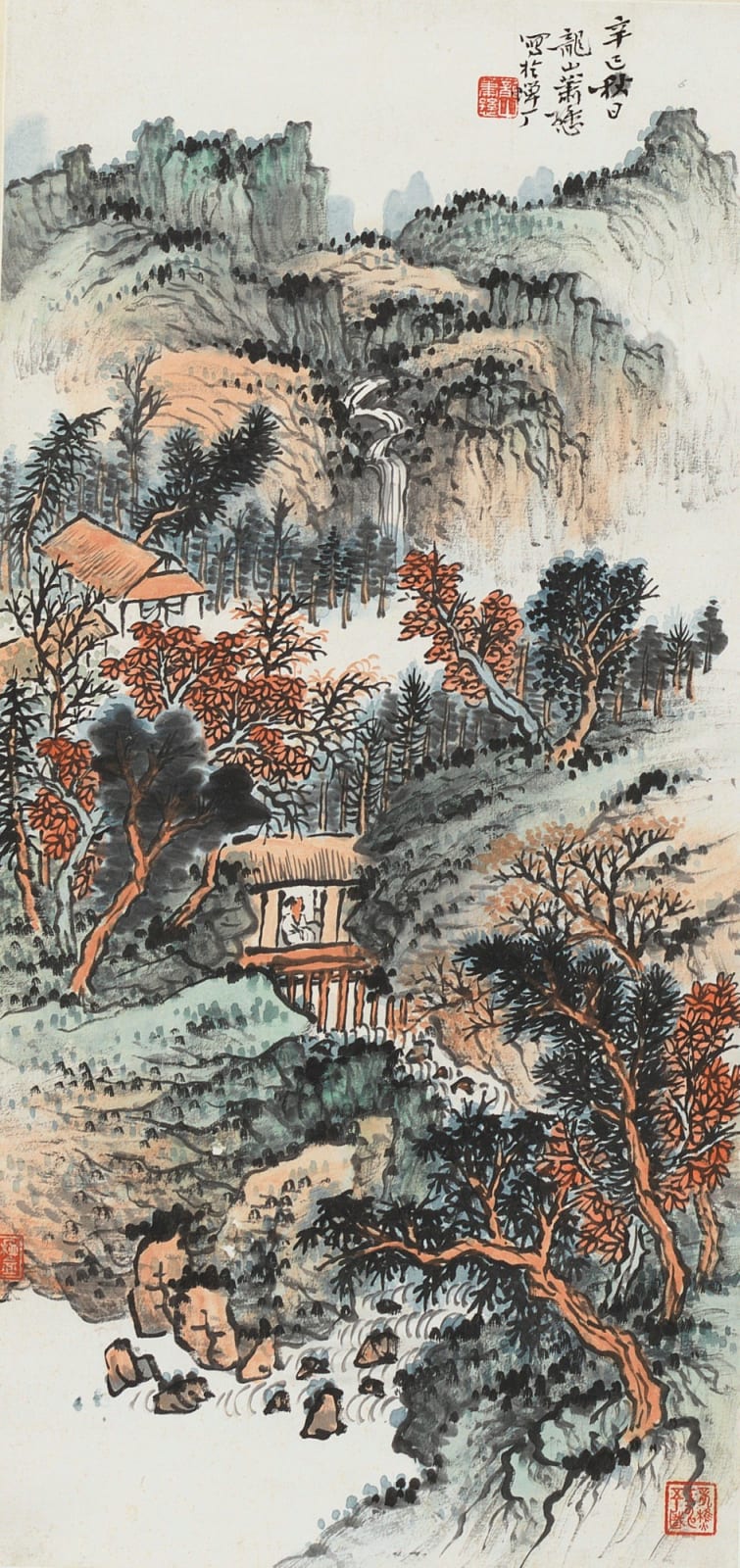-
作品

Xiao Xun
Admiring Chrysanthemums in the Autumn Mountains 秋山獨賞, 1941ink and color on paper, hanging scroll26 5/8 x 13 in
67.5 x 33 cmCopyright The Artist萧愻(1883-1944)是20世纪中国山水画领域的重要画家之一,其创作立足于宋元山水画传统,避开了清代画风的窠臼,体现出他对古典艺术的深入理解和审美判断。早年从师姜筠学习山水画,并曾为其代笔,萧愻的创作技法日趋成熟,打下了深厚的笔墨基础。他广泛游历中国的山川名胜,积累了丰富的自然观察经验,使其艺术视野大为开阔。1921年返回北京后,萧愻潜心研究历代名家作品,尤为推崇石涛、龚贤、梅清等黄山画派代表,通过对这些风格的消化吸收,形成了自成一格的画风。 萧愻的山水画在技法上融合了宋元山水的结构美与明清黄山画派的风格特征。他擅长龚贤的皴法,并在擦、点、染、乾湿浓枯的综合运用上达到了高度的和谐统一。其作品构图饱满、山重水叠,具有深邃的空间感和庄重的气韵。用墨层次分明,乾湿浓淡过渡自然,展现出苍茫雄浑的气势。同时,萧愻在赋彩上兼用浅绛和青绿,色调雅致且富有层次,突显出他对中国传统山水画审美的理解与创新。在其创作中,萧愻超越了宋元之形式,注入对自然的体悟和对山川的情怀,使作品兼具历史纵深感和个人风格的统一,成为当代中国画坛中兼具鉴赏和创作深度的代表性人物。 Xiao Xun was one of the most influential Chinese landscape painters of the 20th century. His art was rooted in the landscape traditions of the Song and Yuan...萧愻(1883-1944)是20世纪中国山水画领域的重要画家之一,其创作立足于宋元山水画传统,避开了清代画风的窠臼,体现出他对古典艺术的深入理解和审美判断。早年从师姜筠学习山水画,并曾为其代笔,萧愻的创作技法日趋成熟,打下了深厚的笔墨基础。他广泛游历中国的山川名胜,积累了丰富的自然观察经验,使其艺术视野大为开阔。1921年返回北京后,萧愻潜心研究历代名家作品,尤为推崇石涛、龚贤、梅清等黄山画派代表,通过对这些风格的消化吸收,形成了自成一格的画风。
萧愻的山水画在技法上融合了宋元山水的结构美与明清黄山画派的风格特征。他擅长龚贤的皴法,并在擦、点、染、乾湿浓枯的综合运用上达到了高度的和谐统一。其作品构图饱满、山重水叠,具有深邃的空间感和庄重的气韵。用墨层次分明,乾湿浓淡过渡自然,展现出苍茫雄浑的气势。同时,萧愻在赋彩上兼用浅绛和青绿,色调雅致且富有层次,突显出他对中国传统山水画审美的理解与创新。在其创作中,萧愻超越了宋元之形式,注入对自然的体悟和对山川的情怀,使作品兼具历史纵深感和个人风格的统一,成为当代中国画坛中兼具鉴赏和创作深度的代表性人物。
Xiao Xun was one of the most influential Chinese landscape painters of the 20th century. His art was rooted in the landscape traditions of the Song and Yuan dynasties, yet he skillfully avoided the rigid styles that characterized the Qing dynasty, showing a refined understanding of classical aesthetics. Early in his career, he trained under Jiang Yun, often assisting him by creating works in Jiang’s style, which helped Xiao develop a solid foundation in brushwork. His travels across China’s famous landscapes enriched his artistic vision, deepening his appreciation for the natural world. After returning to Beijing in 1921, he immersed himself in studying the works of past masters, especially admiring Shitao, Gong Xian, and Mei Qing of the Huangshan School, influences he absorbed and transformed into his own unique style.
Xiao Xun’s landscapes blend the structural beauty of Song and Yuan landscapes with the style of the Huangshan School of the Ming and Qing periods. He mastered Gong Xian’s textured brushstrokes and achieved a natural harmony in his use of techniques, including rubbing, dotting, shading, and a controlled play of dry and wet brushwork. His compositions are dense and layered, with overlapping mountains and rivers that create a profound sense of space and majesty. His brushwork uses layers of ink with smooth transitions between dark and light tones, conveying a powerful, timeless quality. Xiao also added both light red and green-blue hues to his palette, achieving elegant and layered color schemes that reflect traditional Chinese aesthetics while bringing a fresh perspective. His work goes beyond traditional forms, combining his feeling for nature with his own artistic vision, creating a unified style that is both historically grounded and personally expressive. Xiao Xun remains a prominent figure in modern Chinese painting, embodying both artistic depth and innovative spirit.
订阅邮件
* denotes required fields
We will process the personal data you have supplied to communicate with you in accordance with our Privacy Policy. You can unsubscribe or change your preferences at any time by clicking the link in our emails.

